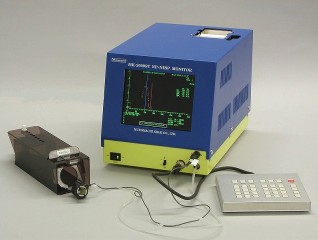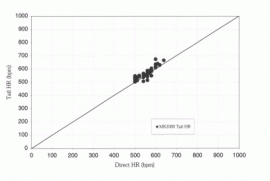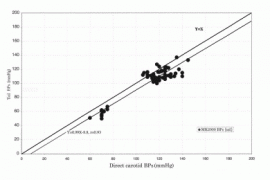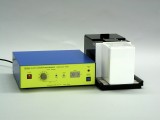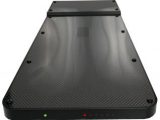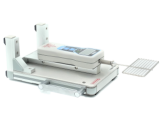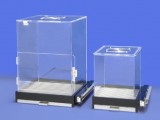Introducing the First and only Non-Preheating, Non-Invasive Blood Pressure Monitor for Mice and Rats in the world
Capable of recording from neonatal mice (1.4 g) to aged rats (1 kg)
Colored mice such as C57BL/6 can be mesured!
Introduction
To measure blood pressure of small animals such as rats or mice using conventional BP Monitors, animals had to be preheated by some means. However, the advent of MK-2000 has made it possible to measure blood pressure without preheating animals provided that the room temperature is at least 23 degrees C. MK-2000ST is the successor to MK-2000 and has become more compact than ever before.
MK-2000ST is ideal for investigating the effects of drugs on animals. Once the animals are restrained properly, just press the START key and HR (Heart Rate), SBP (Systolic BP), MBP (Mean BP) and DBP (Diastolic BP, calculated value) will be automatically measured.
It photoplethysmographically measures pulsatile blood pressure of tail arteries. Pulses are stored into the computer memory and the peak levels of the pulses are plotted on the display. X-axis indicates cuff pressure, and Y-axis indicates amplitude of pulses. Using this method, the operator can decrease the risk of selecting artifacts and BP measurement is made more objective compared to the conventional digital display method.
SBP is initially estimated by inflating the cuff at approximately 25 mmHg/sec. During cuff deflation at about 4-5 mmHg/sec, SBP is determined precisely. SBP is defined as the point when the pulse reappears.
Main Features
- Two operation modes are available.
With Mode 1 HR (Heart Rate) and SBP (Systolic Blood Pressure) are measured. With Mode 2 HR, SBP, MBP (Mean Blood Pressure) and DBP (Diastolic Blood Pressure, calculated value) can be measured.MODE1 HR SBP MODE2 HR SBP MBP (DBP) NOTE:HR (Heart Rate), SBP (Systolic BP), MBP (Mean BP), DBP (Diastolic BP, calculated value)
- Continuous Measurement Function
Continuous measurement can be performed up to ten (10) times. Further, continuous & rapid measurement can also be performed in order to shorten the measuring time. - Rapid Printout Function
Onscreen data including average (AV) and standard deviation (SD), are printed out in about one (1) second by the high-performance thermal printer. Data may also be deleted at the operator’s discretion. - Colored mice such as C57BL/6, neonatal mice weighing 1.4 grams, hamsters (anaesthetized) and guinea pigs (non-anaesthetized), of which blood pressure was so far considered difficult to measure, can be measured.
- Sick animals can be measured. (e.g. animal with cardiac infarction)
- Multi-channel system is no longer needed. Just prepare multiple restrainers, and measurement can be done one after the other.
- Auto-Sequence Function
Blood pressure of a tail artery of an animal can be monitored automatically at specified time intervals, which can be 1 – 99 minutes in length. At each interval, anywhere from 1-10 measurements can be made. This function invokes a series of procedures automatically— measurement, printout of data and transfer to a PC. - Time-Stamp Function
The MK-2000ST precisely records the time of each BP measurement. - Hard Copy Function
The screen on the display can be captured to the thermal printer using the PrtScreen key. - An RS-232C interface is provided on the rear panel of the main unit. Using the optional DCS-2000 Data Collection Software (Windows Version) the data obtained can be exported to a personal computer and stored as a CSV file.
- The animal holders are made of dark brown acryl, allowing BP measurement under relatively stress-free conditions.
- Operation is very simple.
SPECIFICATIONS
Main Unit (MK-2000ST)
| SBP | Cuff pressure when pulse reappears |
| MBP | Cuff pressure when pulse amplitude becomes largest |
| DBP | Calculated value based on SBP and MBP (3MBP-SBP)/2 |
| Detection | LED, Photo Transistor |
| Inflation Range | 0 - 350 mmHg |
| Printer Outputs | Date, Time, Animal No., Weight, Operation Mode, Interval, No of Measuring Trials, Raw Data, Average and S.D. |
| Chart Paper | Thermo-sensitive 58 mm Wide x 25 m Long |
| Power | Please specify your input voltage when ordering. |
| Dimensions | W210 x D310 x H210 mm |
| Weight | Approx. 8 kg |
Keyboard
| Function Keys | 33 |
| Dimensions | W145 x D120 x H20 mm |
| Weight | Approx. 0.4 kg |
The Standard System Comes Supplied with:
- Main Unit (Printer included) – 1
- Keyboard – 1
- Animal Holder (Any one from the list) – 1
- Cuff-pulse Sensor (Any one from the list) – 1
- Measuring Stand for Rats – 1
- TSP-10 Chart Paper (Pack of 5 Rolls) – 1
- APC-2000 Accessory Case – 1
- Dust Cover – 1
- Data Collection Software DCS-2000ST – 1
Animal Holders
| Mouse Holder (3S) | 5 - 10 g |
| Mouse Holder (SS) | 10 - 20 g |
| Mouse Holder (S) | 20 - 30 g |
| Mouse Holder (M) | 30 - 40 g |
| Mouse Holder (L) | 40 - 50 g |
| Rat Holder (3S) | 50 - 70 g |
| Rat Holder (SS) | 70 - 90 g |
| Rat Holder (S) | 90 - 150 g |
| Rat Holder (SM) | 150 - 210 g |
| Rat Holder (M) | 210 - 270 g |
| Rat Holder (ML) | 270 - 350 g |
| Rat Holder (L) | 350 - 500 g |
| Rat Holder (LL) | 500 - 800 g |
Cuff-Pulse Sensors
| Neo24NH | 1.4 - 2 g |
| Neo32NH | 2 - 5 g |
| Neo40NH | 5 - 10 g |
| Mouse NH | 20 - 50 g |
| OB Mouse NH | OB Mouse & Mouse 5 - 20 g |
| C57 Mouse NH | C57BL6 Mouse |
| Hamster (S)NH | Approx. 60 - 80 g |
| Hamster (M)NH | Approx. 80 - 120 g |
| Hamster (L)NH | Approx. 120 - 160 g |
| Rat (S)NH | 90 - 210 g |
| Rat (M)NH | 210 - 350 g |
| Rat (ML)NH | 350 - 500 g |
| Rat (L)NH | 500 - 800 g |
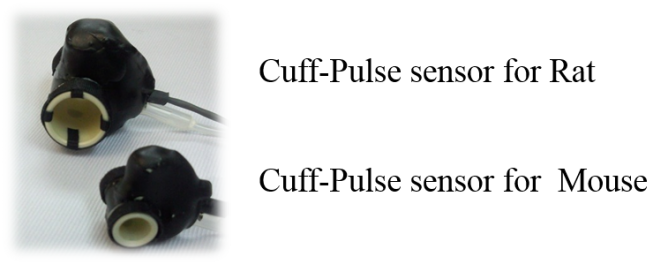
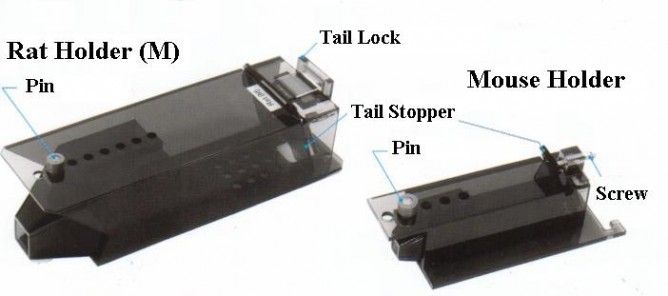
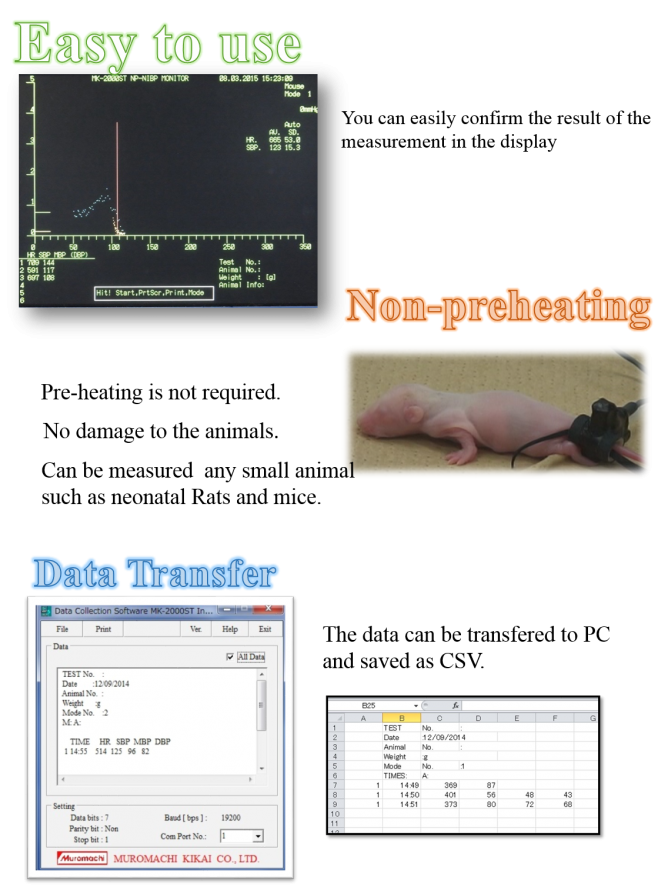
Correlation between simultaneously recorded blood pressures (BP) from carotid catheter and BP measured with the Model MK-2000 in mice. Good correlation was seen in a wide range of BP, which was induced by i.v. infusions of pressor or depressor agents.
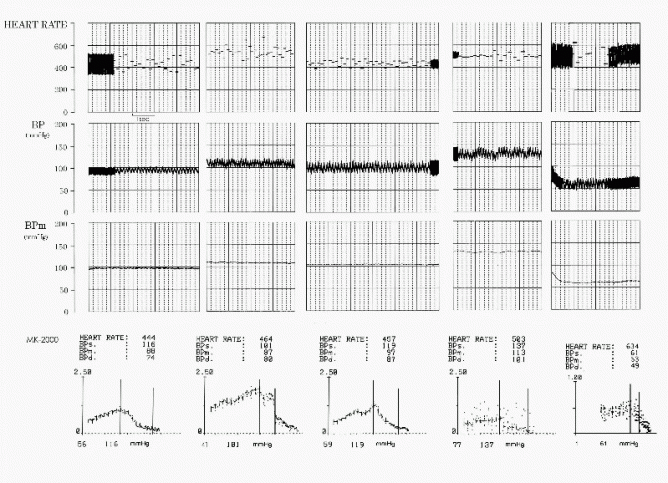
The data was offered courtesy of Prof. Tomoyuki Kuwaki, Ph.D.,
Department of Physiology, Graduate School of Medical & Dental Science,
Kagoshima University
Specifications are subject to change without notice.
REFERENCES:
- Design and production of genetically modified soybean protein with anti-hypertensive activity by incorporating potent analogue of ovokinin (2-7) (FEBS Letters 24860 (2001) 1-5
Nobuyuki Matoba, Naomi Doyama, Yuko Yamada, Nobuyuki Maruyama, Shigeru Utsumi, Masaaki Yoshikawa
Research Institute For Food Science, Kyoto University, Uji Kyoto 611-0011, Japan
Animal used : SHR - Design of a Highly Potent Anti-hypertensive Peptide Based on Ovokinin(2-7) (Biosci. Biotechnol. Biochem.,66(6), 1213-1217,2002)
Yuko Yamada, Nobuyuki Matoba, Hachiro Usui, Kunihiko Onishi, and Masaaki Yoshikawa
Division of Food Bioscience and Biotechnology, Graduate School of Agriculture, Kyoto University, Uji, Kyoto 611-0011, Japan
Animal used : SHR and Wky Rat - Syndecan-4 Deficiency Leads to High Mortality of Lipopolysaccharide-injected Mice (The Journal of Biological Chemistry, Vol. 276, No. 50, Issue of December 14, pp. 47483-47488, 2001)
Kazuhiro Ishiguroö˜, Kenji Kadomatsuö÷, Tetsuhito Kojimaö÷||, Hisako Muramatsuö, Mitsunori Iwase||,
Yasunobu Yoshikai**, Masamitsu Yanadaö˜, Koji Yamamoto˜, Tadashi Matsushita˜, Masahiko Nishimuraöö
Kazuo Kusugami˜, Hidehiko Saito˜ ˜˜, and Takashi Muramatsuö÷÷
From the öDepartment of Biochemistry, ˜First Department of Internal Medicine, **Laboratory of Host Defense & Germfree Life, Research Institute for Disease Mechanism and Control, and ööInstitute for Laboratory Animal Research, Nagoya University School of Medicine, 65 Tsurumai-cho, Showa-ku, Nagoya, Aichi, 466-8550, Japan, the ||Department of Medical Technology, Nagoya University School of Health Sciences, 1-1-20 Daiko-Minami, Higashi-ku, Nagoya, Aichi, 461-8673,Japan, and the ˜˜Nagoya National Hospital, 4-1-1 Sannomaru, Naka-ku, Nagoya, Aichi, 460-0001, Japan - Validity and Application of Noninvasive Measurement of Blood Pressure in Hamsters (Exp.Anim. 52(4), 359-363, 2003)
Kato Y, Iwase M, Kanazawa H, Nishizawa T, Zhao YL, Takagi K, Nagata K, Noda A, Koike Y, Yokota M
School of Health Sciences, Nagoya University, 1-1-20 Daiko-minami, Higashi-ku, Nagoya 461-8673, Japan. - Progressive Development of Pulmonary Hypertension Leading to Right Ventricular Hypertrophy Assessed by Echocardiography in Rats (Exp. Anim. 52(4), 285-294, 2003)
Yosuke KATO1), Mitsunori IWASE1), Hiroaki KANAZAWA1), Natsuki KAWATA1) ,Yukie YOSHIMORI,1)
Katsunori HASHIMOTO1), Toyoharu YOKOI1), Akiko NODA1), Kenzo TAKAGI1), Yasuo KOIKE1),
Takao NISHIZAWA2), Masahiko NISHIMURA2), and Mitsuhiro YOKOTA2)
1)School of Health Science, Nagoya University,1-1-20 Daiko-minami,Higashi-ku, Nagoya 461-8673, and,
2)Graduate School of Medicine, NagoyaUniversity,65 Tsurumai-cho, Showa-ku,Nagoya 466-8550,Japan - Role of host angiotensin II type 1 receptor in tumor angiogenesis and growth (The Journal of Clinical Investigation July 2003 Vol.112, No. 1)
Kimiyasu Egami,1,2 Toyoaki Murohara,1,3,4 Toshifumi Shimada,1,3 Ken-ichiro Sasaki,1,3
Satoshi Shintani,1,3 Takeshi Sugaya,5 Masahiro Ishii,1,2 Teiji Akagi,1,2 Hisao Ikeda,1,3
Toyojiro Matsuishi,1,2 and Tsutomu Imaizumi1,3
1 The Cardiovascular Research Institute,
2 Department of Pediatrics, and
3 Department of Internal Medicine III, Kurume University School of Medicine, Kurume, Japan
4 Department of Cardiology, Nagoya University Graduate School of Medicine, Nagoya, Japan
5 Discovery Research Laboratory, Tanabe Seiyaku Co., Osaka, Japan
Animal used : C57BL6 Mouse - Growth hormone-releasing peptide can improve left ventricular dysfunction and attenuate dilation in dilated cardiomyopathic hamsters (Cardiovascular Research 61 (2004) 30-38)
Iwase, M., Kanazawa, H., Kato, Y., Nishizawa, T., Somura, F., Ishiki, R., Hagata, K., Hashimoto, K., Takagi, K., Izawa, H. and Yokota, - Development of an in vivo Bioassay Method for Allergy-Preventive Substances using HEL-induced Blood Flow Decrease (Biol. Pharm. Bull)
Kyoko Ishiguro1), Hisae Oku1), Yoshimi Ueda1), Emiko Iwaoka1) and Masaru Kunitomo1)
1) School of Pharmaceutical Sciences, Mukogawa Women’s University
Animal used : ddY Mouse - Salt-sensitive hypertension is triggered by Ca2+ entry via Na+/Ca2+ exchanger type-1 in vascular smooth muscle (NATURE MEDICINE Volume 10 Number 11 November 2004)
Takahiro Iwamoto1,3, Satomi Kita1,5, Jin Zhang2, Mordecai P Blaustein2, Yuji Arai4, Shigeru Yoshida5,
Koji wakimoto6, Issei Komuro7&Takeshi Katsuragi1
1 Department of Pharmacology, School of Medicine, Fukuoka University, Fukuoka 814-0180, Japan.
2 Department of Physiology, University of Maryland School of Medicine, Baltimore, Maryland 21201, USA.
3 Department of Molecular Physiology, National Cardiovascular Center Research Institute, Osaka 565-8565, Japan.
4 Department of Bioscience, National Cardiovascular Center Research Institute, Osaka 565-8565, Japan.
5 Medicinal Research Laboratories, Taisho Pharmaceutical Co., Ltd., Saitama 330-8530, Japan.
6 Discovery Research Laboratory, Tanabe Seiyaku Co., Ltd., Osaka 532-8505, Japan.
7 Department of Cardiovascular Science and Medicine, Chiba University Graduate School of Medicine, Chiba 260-8670, Japan.
Animal used : C57BL6 Mouse - The vascular relaxing effects of sevoflurane and isoflurane are more important in hypertensive than in normotensive rats (Canadian Journal of Anesthesia 51: 979-985, 2004)
Jingui Yu, MD*, Koji Ogawa, MD, Yasuyuki Tokinaga, MD*, Shizue Iwahashi, MD* and Yoshio Hatano, MD*
* From the Department of Anesthesiology, and the Surgical Operating Center, Wakayama Medical University, Wakayama City, Japan. - Angiogenesis and Vasculogenesis Are Impaired in the Precocious-Aging klotho Mouse(American Heart Association Circulation. 2004;110:1148-1155.)
Toshifumi Shimada, MD; Yoshiaki Takeshita, MD; Toyoaki Murohara, MD; Ken-ichiro Sasaki, MD;
Kimiyasu Egami, MD; Satoshi Shintani, MD; Yosuke Katsuda, MD; Hisao Ikeda, MD;
Yo-ichi Nabeshima, MD; Tsutomu Imaizumi, MD
From the Cardiovascular Research Institute (T.S., Y.T., T.M., K.-i.S., K.E., S.S., Y.K., H.I., T.I.), Kurume University, Kurume; the Department of Cardiology (T.M.), Nagoya University Graduate School of Medicine, Nagoya; and the Department of Pathology and Tumor Biology (Y.-i.N.), Kyoto University Graduate School of Medicine, Kyoto, Japan. - Effects of Captoprill on Cardiac and Renal Damage, and Metabolic Alterations in the Nitric Oxide-Deficient Hypertensive Rat (Kidney Blood Pressure Research 2005; 28: 243-250)
Mahmoud M. Khattab Adel Mostafa Othman Al-Shabanah
Department of Pharmacology, College of Pharmacy, King Saud University, Riyadh , Saudi Arabia - Rat Phenome Project: The untapped potential of existing rat strains (J Appl Physiol 98: 371-379, 2005)
Tomoji Mashimo, Birger Voigt, Takashi Kuramoto, and Tadao Serikawa
Institute of Laboratory Animals, Graduate School of Medicine, Kyoto University, Kyoto, Japan - An X-Ray Diffraction Study on Mouse Cardiac Cross-Bridge Function In Vivo: Effects of Adrenergic ß-Stimulation (Biophysical Journal 90:1723-1728 (2006)
Ryuji Toh,* Masakazu Shinohara,* Tomofumi Takaya,* Tomoya Yamashita,* Shigeru Masuda,*
Seinosuke Kawashima,* Mitsuhiro Yokoyama,* and Naoto Yagiy
*Division of Cardiovascular and Respiratory Medicine, Department of Internal Medicine, Kobe University Graduate School of Medicine,Kobe 650-0017, Japan; and ySPring-8/JASRI, Sayo, Hyogo 679-5198, Japan - Prostacyclin agonist with thromboxane synthase inhibitory activity (ONO-1301) attenuates bleomycin-induced pulmonary fibrosis in mice (Am J Physiol Lung Cell Mol Physiol 290: L59-L65, 2006.)
Shinsuke Murakami,1,2 Noritoshi Nagaya,1,3 Takefumi Itoh,2 Masaharu Kataoka,1 Takashi Iwase,1
Takeshi Horio,3 Yoshinori Miyahara,4 Yoshiki Sakai,5 Kenji Kangawa,6 and Hiroshi Kimura2
1Department of Regenerative Medicine and Tissue Engineering, National Cardiovascular Center Research
Institute, Osaka; 2Second Department of Internal Medicine, Nara Medical University, Nara; 3Department of
Internal Medicine, National Cardiovascular Center, Osaka; 4Department of Cardiac Physiology, National
Cardiovascular Center Research Institute, Osaka; 5Ono Pharmaceutical Co., Ltd. Research Headquarters,
Osaka; and 6Department of Biochemistry, National Cardiovascular Center Research Institute, Osaka, Japan - Antihypertensive Effect of Angiotensin-Converting Enzyme Inhibitory Peptide Obtained from Hen Ovotransferrin (Journal of the Chinese Chemical Society, 2006, 53, 495-501)
Nai-Yuan Leea, Juei-Tang Chengb, Toshiki Enomotoc, Ichiro Nakamurad,
a Livestock Research Institute, Tainan 712, Taiwan, R.O.C.
b Department Pharmacology, College of Medicine, National Cheng Kung University,
Tainan 70101, Taiwan, R.O.C.
c Department of Food Science, Ishikawa Prefectural University, Nonoichi, Ishikawa 9218836, Japan
d Institute of Animal Experimentation, School of Medicine, Hokkaido University, Sapporo 0608589, Japan
Animal used : SHR - Evaluation of Blood Pressure Measured by Tail-Cuff Methods (without Heating) in Spontaneously Hypertensive Rats (Biol. Pharm. Bull. 29(8) 1756-1758 (2006) Vol. 29, No. 8
KUBOTA Yoko1 UMEGAKI Keizo2 KAGOTA Satomi 3 TANAKA Naoko 4 NAKAMURA Kazuki 5 KUNITOMO Masaru 6 SHINOZUKA Kazumasa 7
1 Department of Biopharmaceutics, Nihon Pharmaceutical University
2 National Institute of Health and Nutrition
3 Department of Pharmacology, School of Pharmaceutical Sciences, Mukogawa Women’s University
4 Department of Pharmacology, School of Pharmaceutical Sciences, Kyushu University of Health and Welfare
5 Department of Pharmacology, School of Pharmaceutical Sciences, Mukogawa Women’s University
6 Department of Pharmacology, School of Pharmaceutical Sciences, Mukogawa Women’s University
7 Department of Pharmacology, School of Pharmaceutical Sciences, Mukogawa Women’s University - Mechanical ventilation with 40% oxygen reduces pulmonary expressionof genes that regulate lung development and impairs alveolar septation in newborn mice
(Am J Physiol Lung Cell Mol Physiol 293:1099-1110, 2007. )
Richard D. Bland, Lucia M. Mokres, Robert Ertsey, Berit E. Jacobson, Shu Jiang, Marlene Rabinovitch,
Liwen Xu, Eric S. Shinwell, Feijie Zhang, and Matthew A. Beasley
Department of Pediatrics, Stanford University School of Medicine, Stanford, California - Mechanical ventilation uncouples synthesis and assembly of elastin and increases apoptosis in lungs of newborn mice.
(Am J Physiol Lung Cell Mol Physiol 294:L3-L14, 2008. )
Richard D. Bland, Robert Ertsey, Lucia M. Mokres, Liwen Xu, Berit E. Jacobson, Shu Jiang,
Cristina M. Alvira, Marlene Rabinovitch, Eric S. Shinwell, and Anjali Dixit
Department of Pediatrics, Stanford University School of Medicine, Stanford, California

